Ina Garten’s Roast Chicken is a perfect recipe for whole, oven roasted chicken and vegetables with plenty of gravy to go around! Your family will love this dinner!
Be sure that you make my easy homemade chicken stock with your roast chicken leftovers!
I couldn’t be more excited to share this recipe with you. If you struggle to make roast chicken, I truly have all of the answers for you right here. Struggle no more, and see how easy it really is!
Here’s what you need, and let’s do this.
PSST! Be sure to read the info in this post prior to skipping to the recipe. You’ll be glad you did!
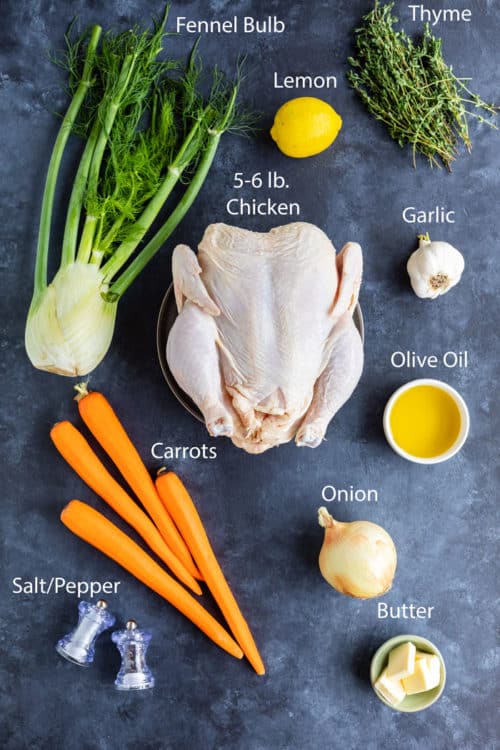
Do not Rinse!
Instead, pat the chicken dry with paper towels.
- Rinsing a whole chicken under water in the sink runs a high risk of splashing germs and bacteria all around your sink, counter tops, and dish towels.
- See this resource for more info.
- Be sure to wash your hands well every time you handle the chicken.
Stuffing a Chicken
- Ina Garden stuffs her roast chicken with two lemon halves, a head of garlic cut crosswise, and a bunch of thyme.
- Lemon and rosemary are a good choice as well.
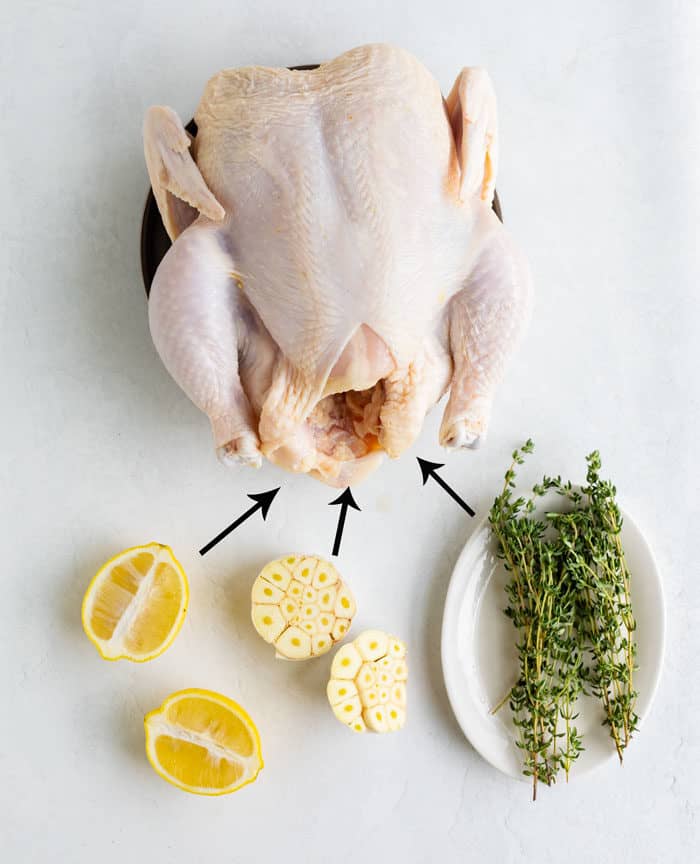
Trussing the Chicken
- Tying the chicken legs with kitchen twine (or “trussing”), is totally optional. Some are actually against it as it can prevent excess air flow from circulating around the breast. (I usually do it just to keep the legs in place.)
- Tuck the tip of the wing underneath the body to prevent it from cooking too quickly/burning.
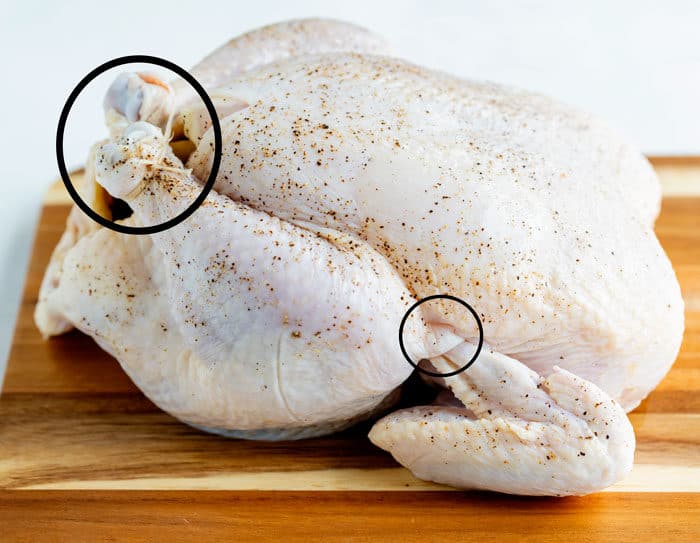
Let the Chicken Sit at Room Temperature
- If time allows, let the chicken sit at room temperature for 30 minutes. This is important for even cooking. Placing cold chicken on the roasting pan can dry out the outside before the inside has a chance to finish cooking.
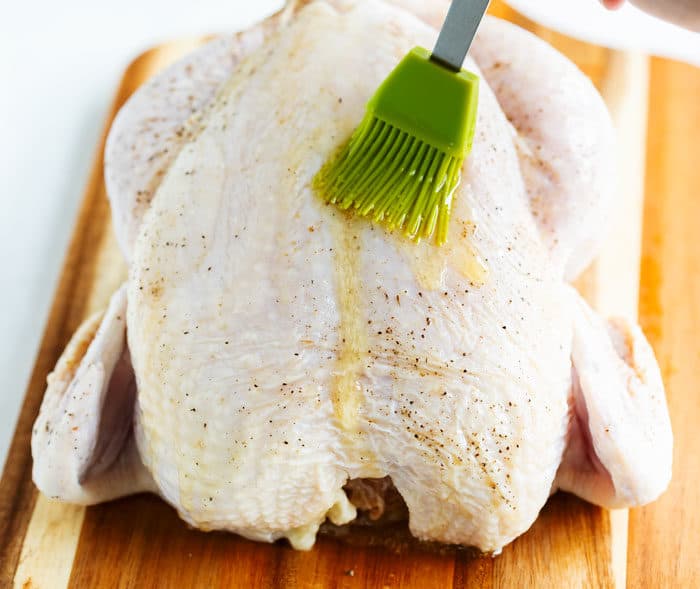
Position the Chicken on Top of the Vegetables in the Roasting Pan
- This allows for more even cooking as the bottom of the chicken won’t be sitting in its’ own juices as it cooks.
- The vegetables also add additional flavor to the chicken drippings, which we’ll be using to make gravy.
Don’t Use a Turkey Roasting Pan
- Use a roasting pan that fits the size of the chicken. Otherwise, the surface area of the pan will be too large and the moisture will evaporate quickly, leaving you with little to no drippings and dry vegetables.
What Temperature to Roast a Chicken
- 425° is a great temperature for roasting chicken and is what Ina Garten recommends. This temperature allows the chicken to roast perfectly evenly without needing to adjust the heat at any point.
- I like to baste the chicken halfway through (spoon the juices onto the top of the skin), and rotate the pan 180° when I put it back in the oven.
How Long to Roast Chicken
- An easy rule of thumb for roasting time is about 15 minutes per pound.
- This chicken was just under 6 pounds and took exactly 1 + 1/2 hours to roast perfectly at 425°.
How to Know When it’s Done
- Press a thigh into the body of the chicken to extract some juice. The juice should run clear.
- Place a meat thermometer into the thigh or thickest part of the breast. The internal temperature should read 165°.
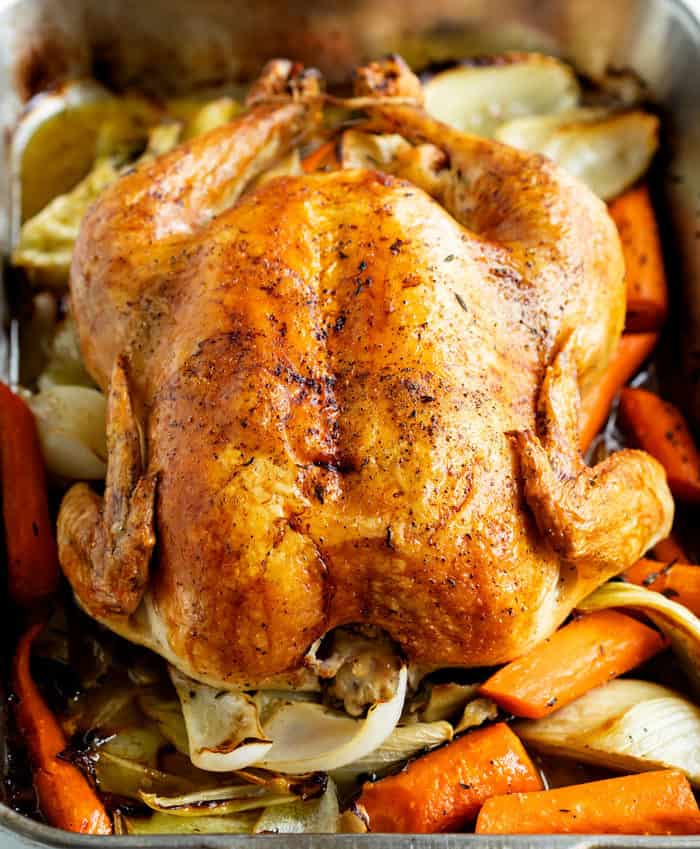
Let it Rest (without foil)
- Let the chicken rest, *uncovered* for a full 15-20 minutes prior to cutting into it. Otherwise the juices will run all over the place instead of getting reabsorbed back into the chicken. We’re going for juicy chicken, not dry!
- Some recipes advise that you cover the chicken with foil as it rests, but that causes moisture to build up in the foil and will make your crispy skin wet. We don’t want soggy skin.
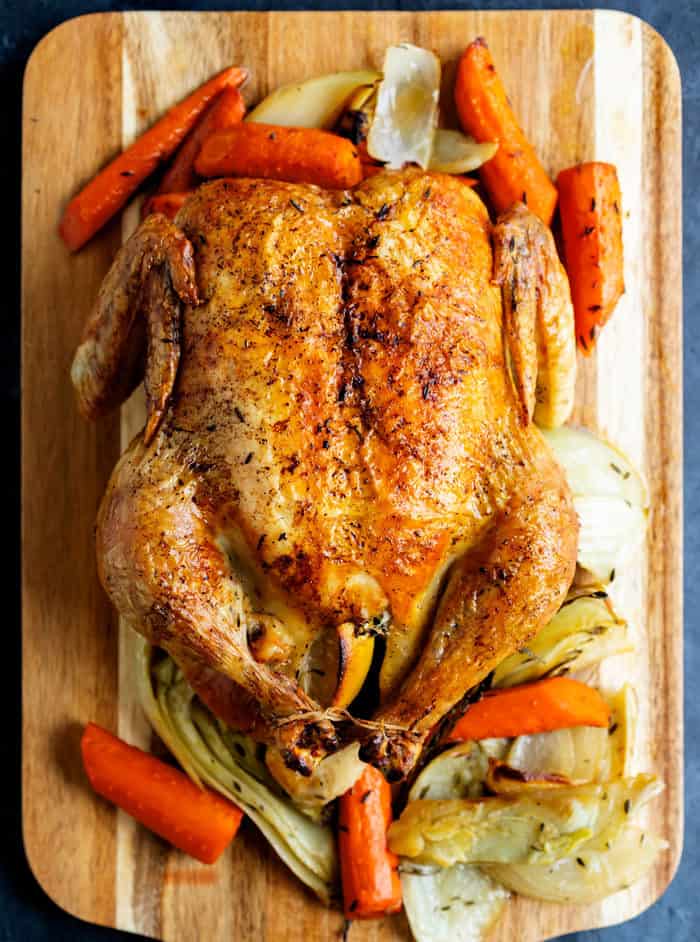
The Chicken Drippings
This nearly 6 lb. chicken left me with 1 + 1/3 cups of chicken drippings to make gravy with.
Let’s get to gravy making…
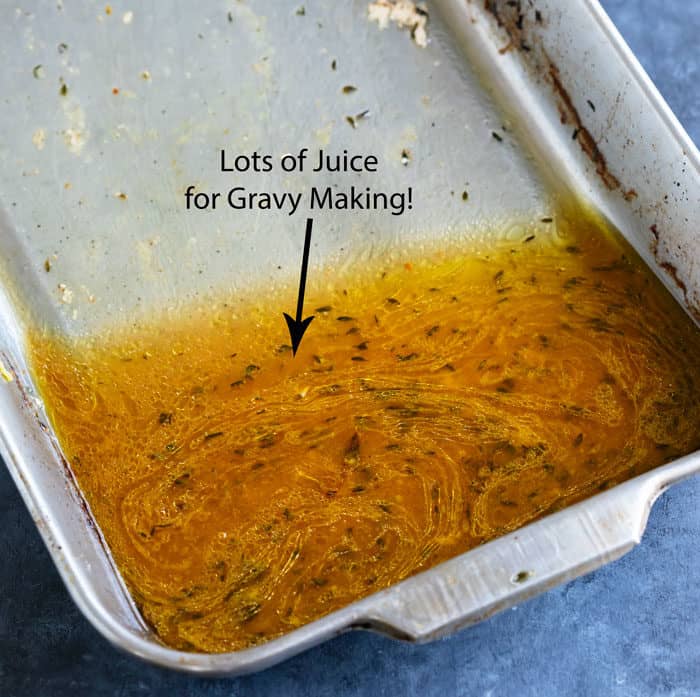
How to Make Chicken Gravy
- Pour the chicken drippings into a large measuring cup.
- Top off the chicken juices with chicken broth to make 2 cups.
- Melt 3 Tablespoons of butter in a saucepan over medium heat.
- Add 3 Tablespoons flour. Whisk for 1 minute.
- Add half of the gravy juice/broth. Whisk until there are no lumps.
- Add remaining liquid. Whisk for 2 minutes. The gravy will continue to thicken more and more.
- Season with salt/pepper if desired. Done!
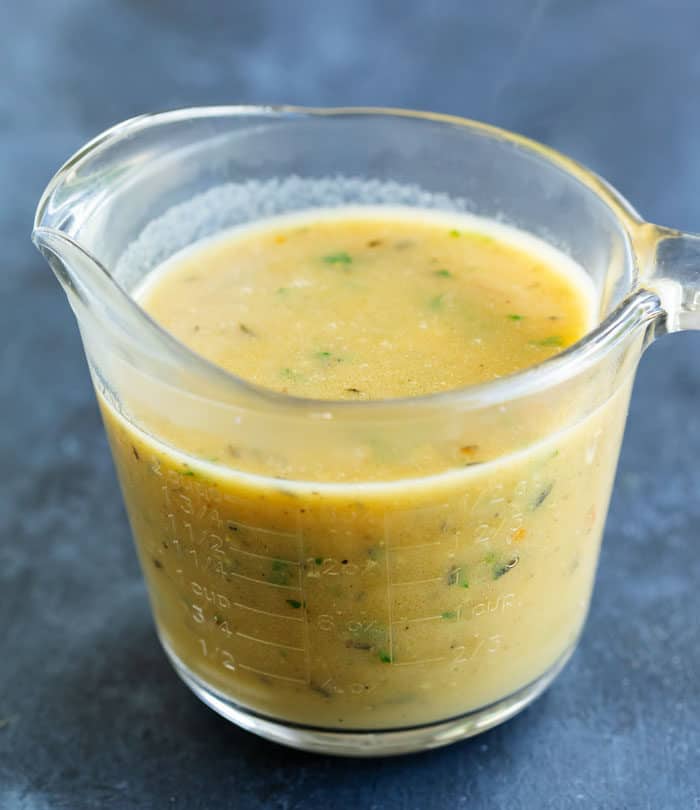
Need More Browning?
- If your chicken needs a touch more color, increase the heat to 500° and use foil to cover up any parts that are already sufficiently browned.
- Roast for an additional 5 minutes or so. Keep a close eye on it.
- Note: This step wasn’t necessary when I prepared this chicken, however I do rotate the pan 180° halfway through for even color.
Pro Tips
- Use a roasting pan that fits the size of your chicken for best results. Using a roasting pan that’s too large runs you the risk of burning the vegetables and losing your liquid for the gravy.
- Use plenty of thick cut vegetables (whole carrots, quartered onions, etc.). If there are too few or if they’re cut too thin, they’ll cook too quickly.
- Gauge how your vegetables look at the halfway mark when you rotate the roasting pan. If they’re cooking too quickly, cover them with a layer of foil (but leave the chicken exposed).
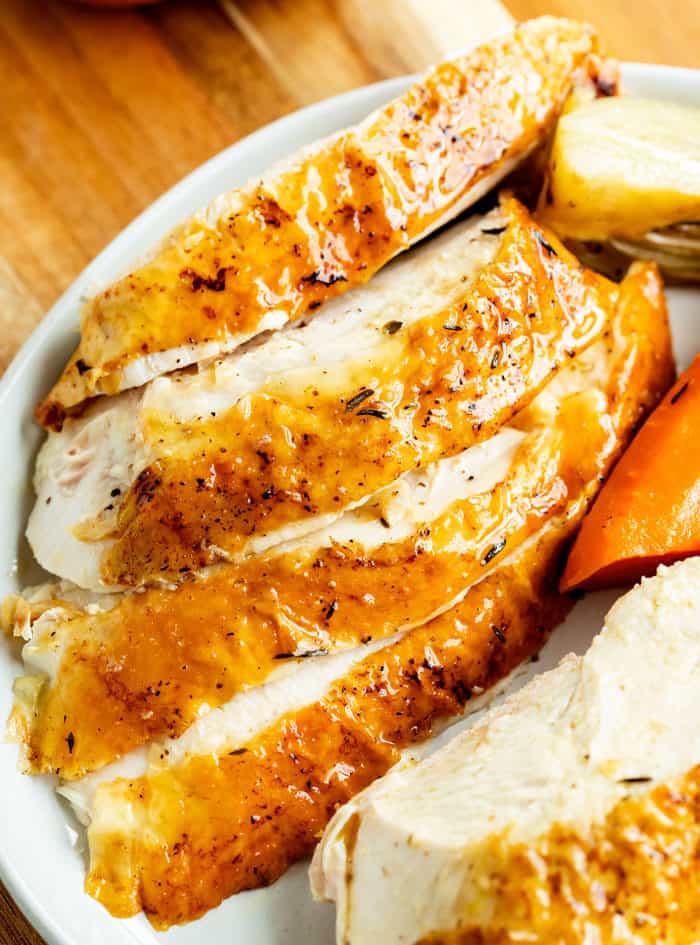
What to Serve with Roasted Chicken
- Mashed Potatoes
- Easy Buttermilk Biscuits
- Roasted Carrots
- Stuffing Casserole (Make up to 3 days ahead!)
- The Pioneer Woman’s Twice Baked Potato Casserole (Make up to 2 days ahead!)
- Paula Deen’s Corn Casserole (Make up to 2 days ahead!)
- Oven Roasted Green Beans (Roasted at the same temp as this chicken!)
- Instant Pot Roasted Potatoes
- Copycat Texas Roadhouse Rolls
Save Your Leftovers!
- Halt! Do not discard anything, especially the carcass/bones, once you’re done with this delicious Roast Chicken.
- Learn how to make easy homemade chicken stock with them! Feel free to freeze your chicken carcass/bones/leftovers until you have time to make it.
Try These Next:
- How to Make Chicken Stock
- Copycat Longhorn Parmesan Crusted Chicken
- Chicken Gravy Recipe -No Drippings Needed!
- Cream of Chicken Soup
- Broccoli Mac and Cheese – One Pot!
- Broccoli Cheddar Chicken and Rice Casserole
Get My Free Meal Plan
I’ve got a Free Meal Plan with 7 of my super popular recipes (complete with grocery list)! Sign up for my email list and I’ll send it over now along with weekly dinner recipes!
And follow me on Facebook, Instagram, and Pinterest!
Did You Make This Recipe?
I would love for you to leave a rating and a comment below! How’d you do?! ⭐⭐⭐⭐⭐
Ina Garten's Roast Chicken
Ingredients
- 5-6 lb. whole chicken
- Salt/Pepper
- 1 large bunch thyme, plus 20 sprigs
- 1 head garlic, cut in half crosswise
- 1 lemon, halved
- 2 Tablespoons butter, melted
- 1 large yellow onion, sliced into large chunks
- 4 whole carrots, sliced into 4-inch chunks
- 1 bulb of fennel, tops removed, cut into wedges
- 2-3 Tablespoons Olive oil
For the Gravy:
- 2/3 cup Chicken Broth
- 3 Tablespoons Butter
- 3 Tablespoons Flour
Instructions
Roasting the Chicken
- Unwrap the chicken and remove the giblets and/or the neck (if included). Pat the chicken dry with paper towels.
- If possible, let the chicken sit at room temperature for 30 minutes to allow for more even cooking.
- Preheat the oven to 425 degrees.
- Seasoning the entire chicken generously with salt and pepper.
- Stuff the chicken with the thyme, garlic, and lemon.
- Brush the outside of the chicken with the 2 TBS melted butter and season again with salt/pepper.
- Use kitchen twine to tie the legs together. Tuck the wings underneath the body of the chicken.
- Place the sliced onions, carrots, and fennel bulb on the bottom of a roasting pan.
- Sprinkle the vegetables with salt, pepper, 20 sprigs of thyme, and drizzle generously with olive oil. Use your hands to toss to evenly coat the vegetables.
- Place the chicken on top of the vegetables. This prevents the chicken from sitting in its own juice while it cooks and elevates the chicken for even cooking.
- Roast (uncovered), for 1 ½ hours. Halfway through, use a spoon to drizzle the chicken with some drippings from the bottom of the pan. Rotate the pan 180 degrees and place it back in the oven.
- The chicken is done when the juices run clear and the internal temperature reads 165 degrees. (Place a meat thermometer into the thigh to check the temperature.)
- Let the chicken rest, uncovered, for 15-20 minutes to allow the juices to reabsorb before you cut into it!
- Slice the chicken on a platter and serve with the roasted vegetables.
Making the Gravy
- Pour the chicken drippings into a large measuring cup.
- Top it off with chicken broth to make 2 cups.
- Melt 3 Tablespoons of butter in a saucepan over medium heat.
- Add 3 Tablespoons flour. Whisk for 1 minute.
- Add half of the gravy juice/broth. Whisk until there are no lumps.
- Add remaining liquid. Whisk for 2 minutes. The gravy will continue to thicken more and more.
- Season with salt/pepper if desired. Done!
- Note: If your chicken needs a touch more color, increase the heat to 500° and use foil to cover up any parts that are already sufficiently browned. Roast for an additional 5 minutes or so. Keep a close eye on it.
Notes
- Use a roasting pan that fits the size of your chicken for best results. Using a roasting pan that's too large runs you the risk of burning the vegetables and losing your liquid for the gravy.
- Use plenty of thick cut vegetables (Large carrots, quartered onions, etc.). If there are too few or if they're cut too thin, they'll cook too quickly.
- Gauge how your vegetables look at the halfway mark when you rotate the roasting pan. If they're cooking too quickly, cover them with a layer of foil (but leave the chicken exposed).
An easy rule of thumb is that chicken takes about 15 minutes/pound to roast at 425 degrees.
Need more Browning?
- If your chicken needs a touch more color, increase the heat to 500° and use foil to cover up any parts that are already sufficiently browned.
- Roast for an additional 5 minutes or so. Keep a close eye on it.
- Save your leftovers to make easy homemade chicken stock!
- You can even freeze your leftovers to make stock another day.
Nutrition
Recipe Source: The Food Network


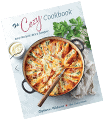 The Cozy Cookbook is here!
The Cozy Cookbook is here! 
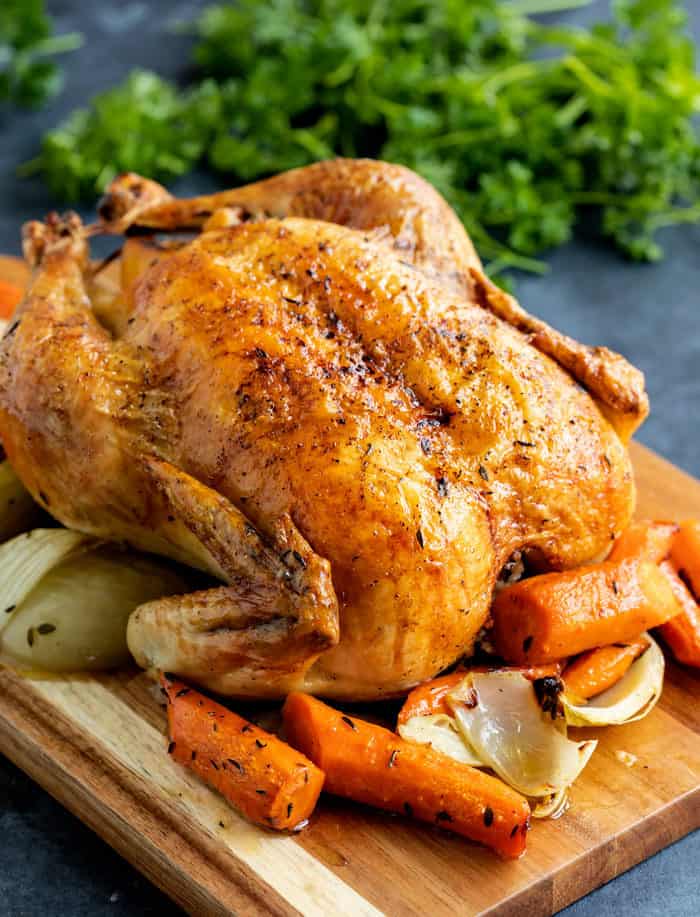
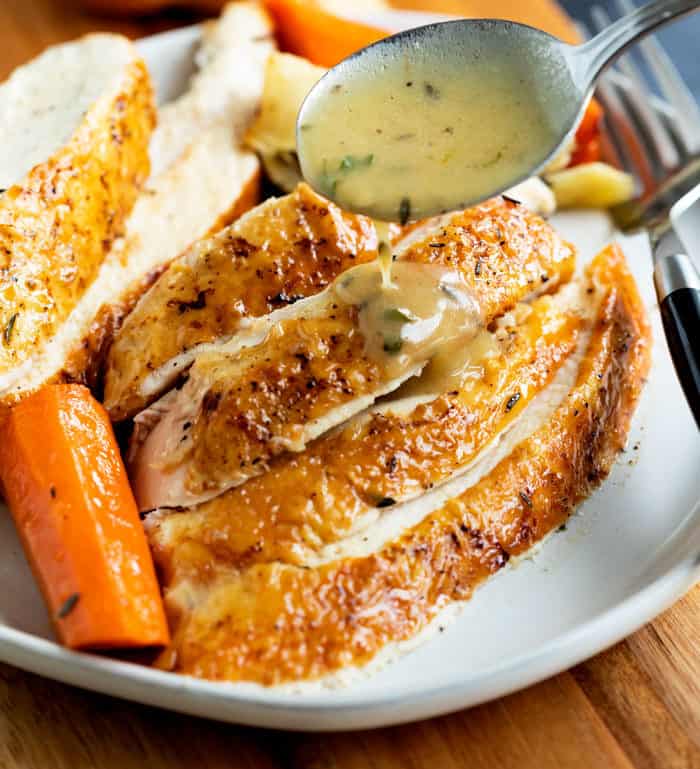
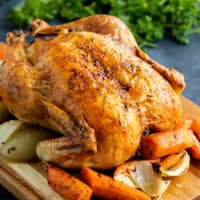
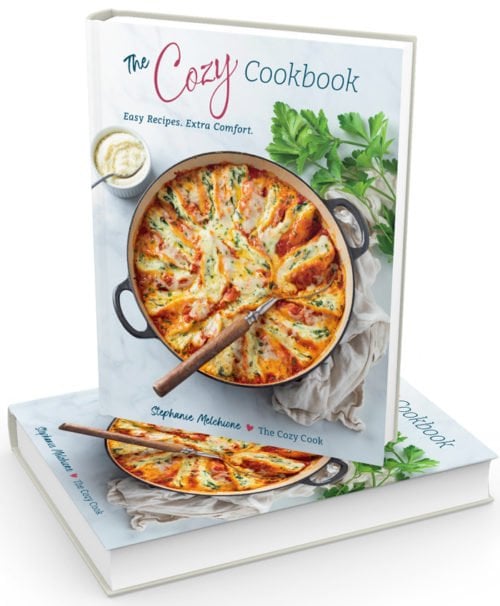
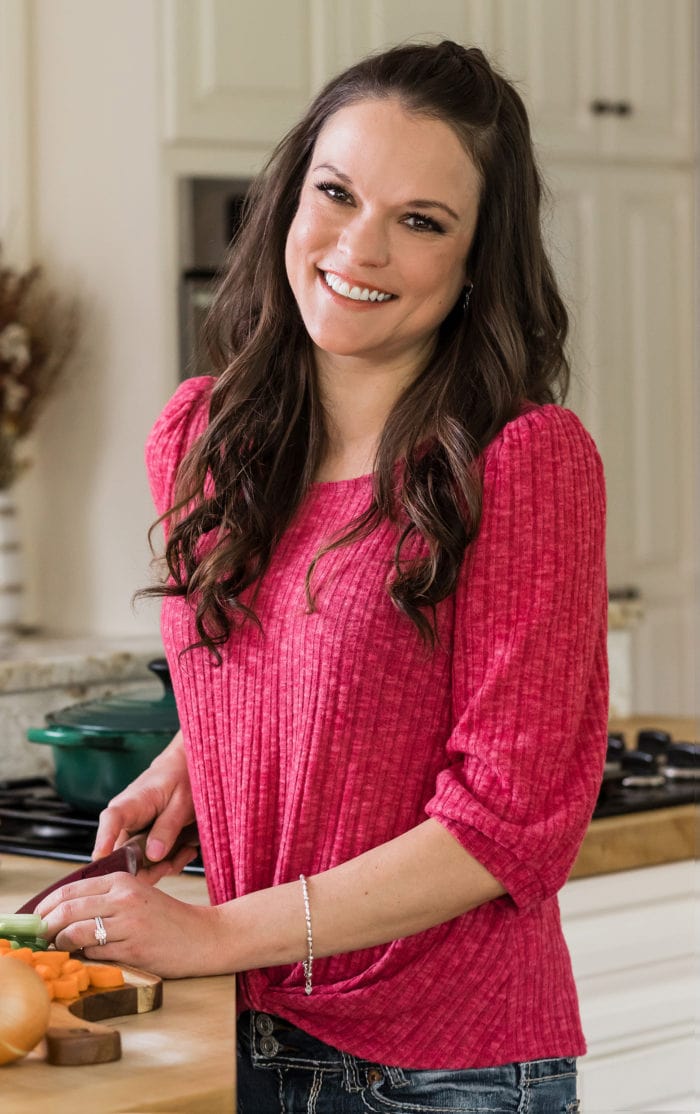
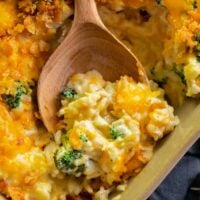
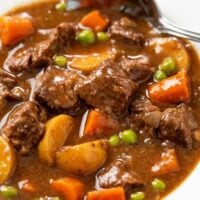
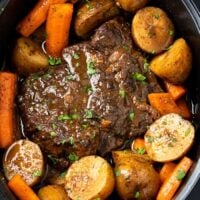
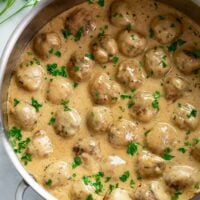
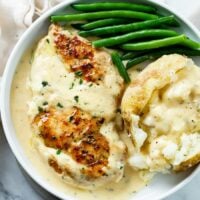
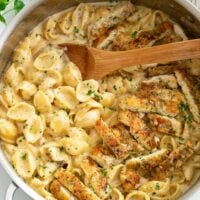

Delicious and browned beautifully.
I can’t wait to make it for my family. I have Covid now, and after 1 week I finally broke down and made it.
Thank you for the best roast chicken ever.
You’re very welcome Laura, thanks so much for the great review!❤️
Can’t wait to make this ! What size pan would you say to use?
Mine is about 9 x 13 inches, it needs to be just large enough to hold the chicken, if it’s too big, the drippings evaporate due to excess surface area 🙂
This is the best roasted chicken I’ve ever made! Usually mine turn out dry and flavorless, but this was juicy and the skin crisp. And it almost tastes like a brine because of the salt. I did use kosher salt instead of table and doubled the butter 😳 ha so so good!!
I am so happy that you enjoyed it Stephanie! This has been my go-to recipe for years and years, it’s never let me down! So glad you loved it too!
This was absolutely amazing, I loved the gravy and the chicken turned out perfect and golden!!
Yesss! I’m so happy this was a winner Katie. Thanks so much for taking the time to leave a comment and review!💗
This is my second roast chicken. The detail given here helped so much. My last chicken was not completely cooked. You explained how to start with the bottom of the chicken facing up and this has made all the difference! I did this and cooked until the chicken was 185 degrees. It was spot on. Nice and moist. Thank you!
I’m so glad you found the instructions helpful Kristine! A good roast chicken is all about technique. Thanks so much for taking the time to leave a review!💗
PS-I had to rate the gravy. I am unable to sleep and I have taken all the natural sleep remedies allowed. So I just had a spoonful of your chicken gravy. Not only is it delicious, but one more spoonful and I think I will be out for the night! It is just heaven. Your recipes are 5 star and I have deleted all the others. ❤️❤️❤️❤️❤️
Omg I love this! Sometimes all you need is a spoonful of comfort Kristine! Thanks so much for your support!💗💗💗
The best and easiest I’ve tried. It will be my ONLY recipe from now on
Wahooo! I’m so happy to hear that, thanks so much for the great comments and review!❤️
I’m just curious, what could I replace the fennel with since my husband does not like fennel but I would like to try this recipe. It looks delicious!
Hi Lauren! I love to use celery instead of fennel!! 🙂
Thank you so much Stephanie! 🙂
You’re very welcome!💗
Used the gravy recipe, added a few cloves of the roasted garlic, thyme and rosemary I had from the chicken in it as well. Pulsed in a food processor then added to the roux and thickened. So tasty. Such an easy recipe to use.
I’m so happy this was a hit! Thanks so much for the great comments and review!😃
Love your comfort food recipes!
No need to print this but potential correction. 🙂
Dark meat is supposed to be cooked higher than 165, right?
“Place a meat thermometer into the thigh or thickest part of the breast. The internal temperature should read 165°.”
I don’t know if this is your recipe or Ina’s but not too sure about some of the verbiage included. For example ‘the inside will dry out’ …. Are you referring to the cavity?
Hi Maura! You’ll want to place the thermometer into the thigh or thickest part of the breast since those are the thickest areas and if those areas are done, you know the whole thing is safely cooked! You are right though, it’s ideal for dark meat to be cooked higher than 165 degrees, but in order to achieve that without drying out/overcooking the breast, you’d need to follow a different technique than what Ina does. One way start the chicken breast-side-down to expose the thighs to the heat first and give it a head start. I do this with my roast turkey recipe and it works wonderfully. The dark meat ends up around 175°-180°, and breast meat is at 165°, which is perfect.
For the other question you had, I said the outside could dry out, (not the inside),- meaning the meat, not the cavity. And that can occur if you place a cold chicken on a roasting pan and pop it in the oven without giving it time to sit out a room temperature for even cooking.
I hope this helps! 🙂 Have a great weekend!
Yummy, now I have another yummy one to add to my prep for Chicken!!